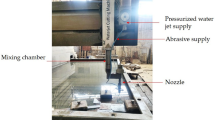Abstract
This paper presents an investigation into the MQL (minimum quantity lubrication) and wet turning processes of AISI 1045 work material with the objective of suggesting the experimental model in order to predict the cutting force and surface roughness, to select the optimal cutting parameters, and to analyze the effects of cutting parameters on machinability. Fractional factorial design and central composite design were used for the experiment plan. Cutting force and surface roughness according to cutting parameters were measured through the external cylindrical turning based on the experiment plan. The measured data were analyzed by regression analysis and verification experiments were conducted to confirm the results. From the experimental results and regression analysis, this research project suggested the experimental equations, proposed the optimal cutting parameters, and analyzed the effects of cutting parameters on surface roughness and cutting force in the MQL and wet turning processes.
Similar content being viewed by others
References
A. E. Diniz and R. Micaroni, Cutting conditions for finish turning process aiming: the use of dry cutting, International Journal of Machine Tools and Manufacture, 42 (2002) 899–904.
J. H. Lee and S. J. Lee, Environment-friendly cutting process technology, Journal of the Korean Society for Precision Engineering, 18 (2001) 31–36.
J. H. Lee, S. J. Lee, S. W. Lee and H. J. Choi, Characteristics of environment-friendly semi-dry turning, Journal of the Korean Society for Precision Engineering, 19 (2002) 221–226.
K. Weinert, I. Inasaki, J. W. Sutherland and T. Wakabayashi, Dry machining and minimum quantity lubrication, CIRP Annals-Manufacturing Technology, 53 (2004) 511–537.
G. Boothroyd and W. A. Knight, Fundamentals of Machining and Machine Tools, Tayler & Francis, (2006).
S. H. Yang, Y. M. Lee and Y. S. Kim, Analysis of cutting properties with reference to amount of coolant used in an environment conscious turning process, KSME International Journal, 18 (2004) 2182–2189.
S. J. Heo, Environmentally conscious hard turning of cemented carbide materials on the basis of micro-cutting in SEM: stressing four kinds of cemented carbides with PCD tools, Journal of Mechanical Science and Technology, 22 (2008) 1383–1390.
A. R. Machado and J. Wallbank, The effect of extremely low lubricant volumes in machining, International Journal on the Science and Technology of Friction, Lubrication and Wear, 210 (1997) 76–82.
N. R. Dhar, M. W. Islam, S. Islam and M. A. H. Mithu, The influence of minimum quantity of lubrication on cutting temperature, chip and dimensional accuracy in turning AISI-1040 steel, Journal of Materials Processing Technology 171 (2006) 93–99.
N. R. Dhar, M. Kamruzzaman and M. Ahmed, Effect of minimum quantity lubrication on tool wear and surface roughness in turning AISI-4340 steel, Journal of Materials Processing Technology, 172 (2006) 299–304.
D. U. Braga, A. E. Diniz, G. W. A. Miranda and N. L. Coppini, Using a minimum quantity of lubricant (MQL) and a diamond coated tool in the drilling of aluminum-silicon alloys, Journal of Materials Processing Technology, 122 (2002) 127–138.
A. Attanasio, M. Gelfi, C. Giardini and C. Remino, Minimal quantity lubrication in turning: effect on tool wear, International Journal on the Science and Technology of Friction, Lubrication and Wear, 260 (2006) 333–338.
F. Itoigawa, T. H. C. Childs, T. Nakamura and W. Belluco, Effects and mechanisms in minimal quantity lubrication machining of an aluminum alloy, International Journal on the Science and Technology of Friction, Lubrication and Wear, 260 (2006) 339–344.
Y. K. Hwang, W. J. Chung, J. Y. Jung and C. M. Lee, A study on the improvement of cutting force and surface roughness in MQL turning, Transactions of the Korean Society of Machine Tool Engineers, 15 (2006) 83–91.
Y. K. Hwang, W. J. Chung and C. M. Lee, Experimental study of cutting force and surface roughness prediction in MQL turning of Al 6061, Journal of the Korean Society for Precision Engineering, 25 (2008) 159–167.
Y. K. Hwang, A study on the improvement of machinability in MQL turning using design of experiments, M.S. Thesis, Changwon National University, (2005).
www.vogelag.com
www.taegutec.co.kr
R. H. Myers and D. C. Montgomery, Response surface methodology, A Wiley-Interscience Publication, (2002).
S. H. Park, Design of Experiments, Minyoungsa, (2002).
www.minitab.co.kr
M. C. Show, Metal cutting principles, Oxford University Press, (2005).
Author information
Authors and Affiliations
Corresponding author
Additional information
This paper was recommended for publication in revised form by Associate Editor Dae-Eun Kim
Young-Kug Hwang received his Ph.D. in Mechanical Design and Manufacturing Engineering from Changwon National University in 2010. His research interests include high speed spindle design, variable preload technology of machine tool and environmental conscious machining.
Choon-Man Lee received his Ph.D. degree in Production Engineering from KAIST in 1989. Dr. Lee is currently a Professor at the Department of Mechanical Design and Manufacturing Engineering at Changwon National University. His research interests include plastic working, computer aided manufacturing, machine tool and production engineering.
Rights and permissions
About this article
Cite this article
Hwang, Y.K., Lee, C.M. Surface roughness and cutting force prediction in MQL and wet turning process of AISI 1045 using design of experiments. J Mech Sci Technol 24, 1669–1677 (2010). https://doi.org/10.1007/s12206-010-0522-1
Received:
Revised:
Accepted:
Published:
Issue Date:
DOI: https://doi.org/10.1007/s12206-010-0522-1




